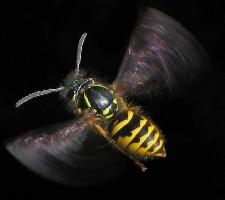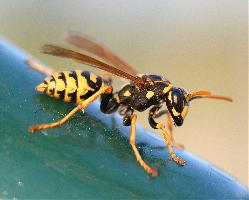
Poids et mesures
| Longueur | de 11 à 18 mm |
|---|
Statut de conservation
| Intrépide |
Description de l'animal
The Median wasp, scientifically known as Dolichovespula media, is a striking species of social wasp that belongs to the family Vespidae. This species is particularly noted for its significant size and distinctive markings, making it one of the more easily recognizable wasps in its range. The Median wasp can be found across various parts of Europe and Asia, and its presence has also been recorded in North Africa. Over the years, there has been a noticeable northward expansion in its distribution, possibly due to climate change, making it a species of interest in studies related to global warming and its impact on insect migration.Adult Median wasps exhibit a considerable size variation, with queens typically measuring between 18 to 22 millimeters in length, while the workers are somewhat smaller, ranging from 12 to 17 millimeters. Males fall within this size range as well. One of the most distinguishing features of the Median wasp is its coloration; it has a predominantly black body adorned with yellow markings. The patterns on its abdomen, which consist of a series of yellow bands, are key identifiers. Unlike some of its relatives, the Median wasp has a relatively slim waist (petiole) that connects the thorax to the abdomen, contributing to its sleek appearance.
The behavior of Dolichovespula media is typical of social wasps. They construct their nests in sheltered locations, often choosing sites like hollow trees, attics, or under eaves. The nests are made from chewed wood fibers mixed with saliva, resulting in a papery material. These structures can become quite large, housing hundreds of individuals, and are characterized by multiple layers of hexagonal cells covered by an outer envelope. The queen initiates the nest in the spring, laying eggs that will develop into workers. These workers then take over the duties of expanding the nest and caring for subsequent offspring, including future queens and males towards the end of the summer.
The diet of the Median wasp is varied, consisting of nectar, tree sap, and other sweet substances. However, they also play a significant role as predators, hunting various arthropods to feed their larvae. This predatory behavior makes them valuable in controlling pest populations, although they can become nuisances when they venture too close to human activities, especially in search of sugary foods.
Despite their beneficial role in natural ecosystems, Median wasps can pose a threat to humans due to their ability to sting. They are generally non-aggressive towards humans unless their nest is disturbed. Their sting, while painful, is usually not dangerous except to individuals with allergies to wasp venom.
In conclusion, the Median wasp is a fascinating species with a broad geographical range and a notable presence in the ecosystems it inhabits. Its distinctive appearance, complex social structure, and interactions within the environment make it an intriguing subject for both entomologists and nature enthusiasts alike. As with many species, understanding the behavior and ecological role of the Median wasp is crucial for appreciating the biodiversity and intricacies of our natural world.
Animaux similaires
Nouvelles photos d'animaux
Top 10 des animaux
- Dolphin gull (Leucophaeus scoresbii)
- Japanese macaque (Macaca fuscata)
- Stone loach (Barbatula barbatula)
- Greek tortoise (Testudo graeca)
- Russian tortoise (Testudo horsfieldii)
- Galápagos tortoise (Geochelone nigra complex)
- Diana monkey (Cercopithecus diana)
- Moustached guenon (Cercopithecus cephus)
- Common flying dragon (Draco volans)
- Galápagos penguin (Spheniscus mendiculus)


